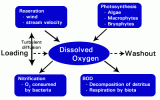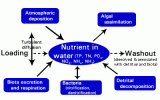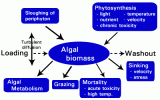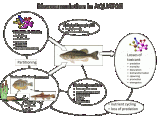Potential Applications for AQUATOX
- Intended Application of AQUATOX
- Nutrient and eutrophication analysis
- Links between water quality and aquatic life
- Bioaccumulation and ecological effects of organic toxicants
AQUATOX has a myriad of potential applications to water management issues and programs, including water quality criteria and standards, TMDLs (Total Maximum Daily Loads), and ecological risk assessments of aquatic systems. AQUATOX can be used to predict ecological responses to proposed management alternatives. It may help to determine the most important of several environmental stressors, e.g. where there are both nutrients and toxic pollutants.
The choice of an appropriate model or other tool depends upon the kinds of questions to be answered, the complexity of the situation, and the consequences of the outcome. AQUATOX should be considered where the user needs to understand the processes relating the chemical and physical environment with the biological community.
- Where ecological and biological processes are complex
- Where indirect effects are important but difficult to monitor
- When one needs to articulate linkages between nutrients and biotic community
- When one needs to:
- Evaluate biological responses to alternative pollution reduction scenarios
- Explore possible biological changes in response to climate change
- Explore possible biological changes in response to invasive species
- Where the environmental conditions may change appreciably
Intended Application of AQUATOX
AQUATOX is intended to be used at any one of several levels of application. Like any model, it is best used as one of several tools in a weight-of-evidence approach. The level of required precision, rigor, data, and user effort depend upon the goals of the modeling exercise and the potential consequences of the model results.
Perhaps its most widespread use is as a screening-level model requiring few changes to default studies and parameters. In fact, it was originally developed as an evaluative model to assess the fate and effects of pesticides and industrial organic chemicals in representative or “canonical” environments. It is especially useful in taking the place of expensive, labor-intensive mesocosm tests. Also, with little effort the model can provide insights into the potential impacts of invasive species and the possible effects of control measures, such as pesticide application, on the aquatic ecosystem.
In recent years AQUATOX has been applied as part of the process of developing water quality targets for nutrients. This application has involved setting up the model and calibrating with available data for rivers and reservoirs receiving nutrients from wastewater treatment plants, agricultural runoff, and background “natural” loadings. A certain amount of site-specific biotic, water quality and flow data is required, as well as pollutant loading data, for calibration. However, once the model is set up and calibrated for a site, it is relatively easy to represent a series of loading scenarios and determine threshold nutrient levels for deleterious impacts such as nuisance algal blooms and anoxia. This is important because the intent of setting water quality targets is to model ecological communities under changing conditions as a result of environmental management decisions; this would give better assurance that the sometimes costly pollution reduction actions would render the desired environmental result.
The most intensive, time-consuming application of AQUATOX is in environmental remediation projects, such as Natural Resource Damage Assessments and SUPERFUND. Because of the likely litigation and the potential for costly remediation, this level of application requires site-specific calibration and validation using quality-assured data, usually collected specifically for the model. In dynamic systems, linkage to an equally well calibrated and validated hydrodynamic model is essential to represent, for example, burial and exhumation of contaminated sediments.
Nutrient and eutrophication analysis

AQUATOX is well suited for analysis of waterbodies under stress from nutrient enrichment, such as nuisance algal blooms. Potential applications would include development or evaluation of water quality criteria for nutrients, TMDLs, and analysis of management alternatives.
AQUATOX simulates numerous inter-related variables important in nutrient and dissolved oxygen dynamics, and their effects on the resident aquatic life.
- Nitrogen (total, nitrate, ionized and un-ionized ammonia)
- Phosphorus (total, total soluble phosphate)
- Dissolved oxygen
- Algal biomass, chlorophyll a
- Periphyton biomass and chlorophyll a
- Macrophytes
- Secchi depth (a measure of water clarity)

AQUATOX is applicable to vertically stratified lakes and reservoirs.
- Simulates stratification and differing conditions in each layer
- Simulates multiple types of phytoplankton, so that it can predict successive blooms throughout season
- Includes ability to stimulate management alternatives such as controlled water release from different layers in a reservoir.
Model Validation Reports for details on applications of AQUATOX for nutrient analysis in Onondaga Lake, New York and Coralville Reservoir, Iowa.

AQUATOX can model streams.
- One of the only water quality models that simulates how periphyton (attached algae) respond to nutrients, grazing, and flow. See Modeling Periphyton with AQUATOX for more details.
- Simulates macrophytes
- Simulates multiple types of benthic invertebrates and fish
- Includes ability to link together multiple segments

AQUATOX was successfully calibrated and validated against independent data in Walker Branch, Tennessee to simulate periphyton responses to nutrients, heavy grazing by snails, and variable flow. Similarly, it was used to simulate experimental streams in France (Sourisseau et al. 2007, in Publications). AQUATOX can be used to evaluate ecosystem responses to proposed control actions.
Links Between Water Quality and Aquatic Life
Unlike most water quality models, AQUATOX treats the biota as integral to the chemical/physical system. It has potential applications in analyzing the cause and effect relationships between the chemical and physical environment and biological responses.

AQUATOX represents the effects of nutrients and organic toxicants on the aquatic life.
- Predict relative abundance of algal groups
- Simulates the trophic (feeding) relationships within the biological community
- Simulates the direct and indirect effects of stressors
- Articulates ecological linkages
- Calculates time varying ecological and biological processes
- Demonstrates relative importance of biotic groups over time
- Test sensitivity of biological responses to individual stressors
- Analyzes contributions of multiple stressors

The Model Validation Report for Coralville Reservoir includes analysis of the biological community.
Bioaccumulation and ecological effects of organic toxicants
AQUATOX has the ability to model bioaccumulation of organic toxicants, as well as their direct and indirect effects on the biota.

- Partitioning to water, sediments and biota
- Toxic organic chemical transformations
- Dietary uptake and food web biomagnification, including bioaccumulation in sea gulls, eagles, mink or other wildlife that feed on aquatic organisms and carcasses
- Calculation of bioaccumulation factors
- Toxic effects on biota, and subsequent effects on food web.
The Model Validation Report for Lake Ontario, includes computation of bioaccumulation factors and comparison with two other bioaccumulation models.
